Global War
In a global war, innumerable lives are lost, extensive property damage occurs, and most importantly, human suffering goes beyond all measurable scales. As humans, we need to learn from bygone wars how to live harmoniously with our fellow human beings.
Let us briefly review some of the famous sayings about the war.
“The world must know what happened, and never forget.” — Dwight D. Eisenhower
“December 7, 1941. A date which will live in infamy.” — Franklin D. Roosevelt
“Never in the field of human conflict was so much owed by so many to so few.” — Winston Churchill
Three World Stages in World War II
To simplify the complex World War II (WWII), I like to divide the global stage into three:
- The center stage = Europe
- The western stage = USA
- The eastern stage = Japan
In this blog, we will focus primarily on the center stage. WWII began in the center stage and ended in the eastern stage.
Remember the number “6”
- 6 years – preparation
- 6 years – war
WWII is a 6-year war from September 1, 1939 to September 2, 1945, and it took 6 years of preparation (1933-1939) by Hitler and the Nazi Party (National Socialist German Workers’ Party).
In this blog, we shall mostly focus on the later 6 years of WWII.
The Good Guys & the Not-So-Good Guys of WWII:
Good Guys = Allied Forces – The “Big Three” Allied countries were Great Britain, the Soviet Union (entry in June 1941), and the USA (entry on December 8, 1941). France was part of the Allies except during its German occupation of 1940-44. China and other countries [Poland (German invasion of Poland started WWII), Australia, New Zealand, Canada, the Netherlands, Yugoslavia, Belgium, and Greece] were also part of the Allies.
Not-So-Good Guys = Axis Power – Germany, Italy, and Japan.
Leaders of Allied Powers
- Great Britain – Winston Churchill
- United States – Franklin D. Roosevelt (FDR), Harry S. Truman after FDR’s death
- Russia – Joseph Stalin
- France – Charles de Gaulle
Leaders of Axis Powers
- Germany – Adolf Hitler
- Italy – Benito Mussolini
- Japan – Michinomiya Hirohito
Hitler’s Psychopathic Dark Ambition
Relevant quotes:
- “I no longer listen to what people say, I just watch what they do. Behavior never lies.” — Winston Churchill
- “As I grow older, I pay less attention to what men say. I just watch what they do.” — Andrew Carnegie
Comment: If world leaders had paid less attention to what Hitler said and paid more attention to what he did (Read below “Testing the Waters”), the world may have been a better place and WWII may have been averted or diminished.
Hitler’s megalomaniac ambition appears to have been the vast takeover of Europe, including Britain (the largest European island, located in the North Atlantic Ocean, off the northwest coast of continental Europe), then the Soviet Union (23% in Europe, 77% in Asia), and finally possibly the USA, toward a possible global domination!
Pre-War Signs and Hitler’s Testing the Waters:
Hitler was fully aware of some of the biggest global players, namely, the USA, Britain, France, and the Soviet Union. He wanted to first test the waters to see if these big powers would react to his aggressive takeover of other countries in Europe. He tested the waters through takeover of three places:
- The Rhineland (demilitarized zone of Germany)
- Austria
- Czechoslovakia (two prongs takeover)
- Sudetenland (western Czechoslovakia)
- Remainder of Czechoslovakia
Hitler’s First Attempt at Testing the Waters:
Three years after Hitler came to power, on March 7, 1936, German troops entered and took over the Rhineland, a demilitarized zone along the Rhine River in western Germany. In so doing, Hitler violated the Treaty of Versailles (June 28, 1919) and the Locarno Pact (December 1, 1925). This takeover resulted in no military response from Britain or France.
Hitler’s Second Attempt at Testing the Waters:
Two years later, on March 12, 1938, Hitler’s German troops marched into Austria and annexed it. Austria remained part of Germany until the end of WWII. This German aggression resulted in no major action from Britain and France.
Hitler’s Third Attempt at Testing the Waters:
Having annexed the Rhineland and Austria with no military move from Britain or France, Hitler’s focus was cast on Czechoslovakia. Unknown to other world powers, Hitler planned to take over Czechoslovakia in two stages.
At the end of World War I, Czechoslovakia (Czech and Slovak) was formed from the collapsing Austro-Hungarian Empire and comprising lands from Slovakia, Bohemia, and Moravia. Western Czechoslovakia had a significant German minority population in the Sudetenland (northwestern Bohemia and northern Moravia) in the vicinity of the Sudeten mountain ranges. Hitler wanted the Sudetenland under the pre-text of its German-speaking population. Hitler’s wishes were granted at the Munich Agreement on September 29, 1938, which permitted German annexation of the Sudetenland, i.e., the western part of Czechoslovakia.
The Munich Agreement was signed between Chamberlain (Britain), Daladier (France), Hitler (Germany), and Mussolini (Italy). This resulted primarily from the motive of countries like Great Britain and France to avoid military confrontation with Germany. It is an example of an inappropriate appeasement to an aggressive leader, Hitler, intended to avert war, but it gave away the Sudetenland in western Czechoslovakia to Germany. Churchill criticized then British Prime Minister Neville Chamberlain and the Munich Agreement. On October 5, 1938, Churchill delivered a speech to the House of Commons entitled, “A Total and Unmitigated Defeat.”
Hitler’s Fourth & Final Attempt at Testing the Waters:
Five-and-a-half months after the Sudetenland takeover, on March 16, 1939, German troops marched into the remainder of Czechoslovakia. Britain and France did nothing to retaliate militarily.
Beginning of WWII:
Emboldened by previous victories, Hitler now decided to attack Poland. However, to play it safe, he decided to make a treaty with what appeared to be one of his worst enemies, the Soviet Union so that the Russians wouldn’t get in his way. He disliked the Communists and planned to invade the Soviet Union later, yet he made a pact with his enemy! This is the Hitler-Stalin Pact or the Molotov-Ribbentrop Pact of August 23, 1939—a promise not to attack each other in war, and a secret promise to invade Poland and divide it between the two countries. It was signed in Moscow by Soviet Foreign Minister Vyacheslav Molotov and German Foreign Minister Joachim von Ribbentrop.
It is important to note that the course of history may have been different had the following happened:
- April 1939 – Stalin recommended an alliance between Russia, Britain, and France against Germany.
- If the above alliance had happened, Hitler may not have invaded Poland, for that would mean war against Russia.
- But this alliance did not happen, and it was prolonged for four months into August without any signed agreement.
- Instead, on August 23, 1939, suddenly, the Hitler-Stalin Pact was signed, paving the way to a Nazi invasion of Poland.
Polish Invasion
On September 1, 1939 (9 days after the Pact), Nazi Germany invaded Poland from the west, which commenced WWII. On September 3, 1939, Britain and France declared war on Germany. Sixteen days later, on September 17, 1939, the Soviet Union invaded Poland from the eastern side, and with this bi-prong attack, Poland soon fell.
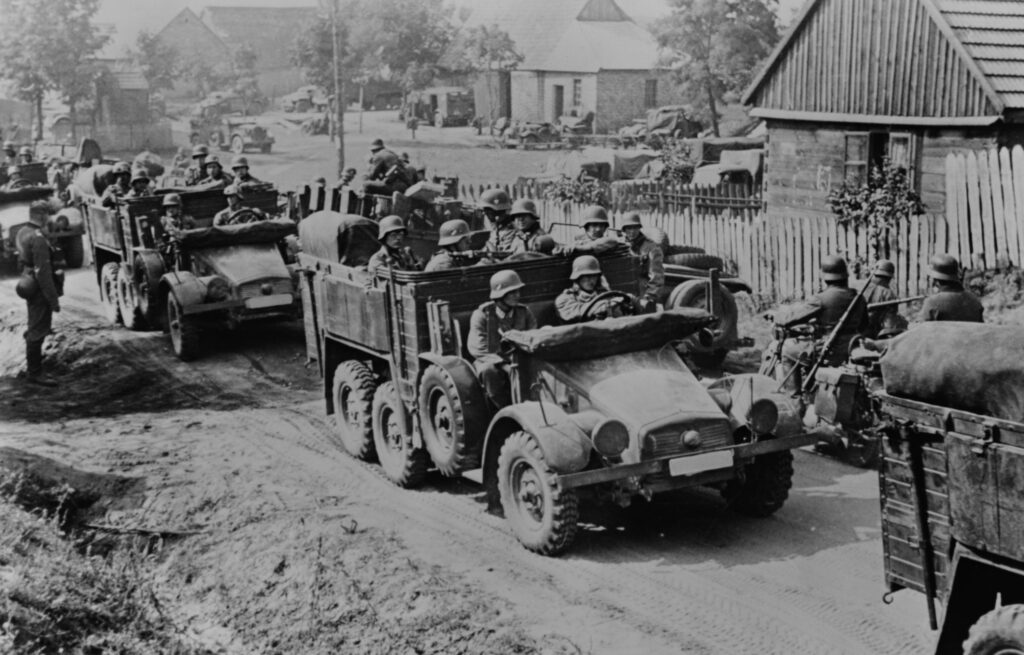
Phony War—Quiet on Land, Active at Sea
Journalists called the six-month period between October 1939 and March 1940 the Phony War. During these early months of WWII, there were no major land hostilities.
However, sea warfare during this time was anything but phony with the German U-boats sinking numerous Allied merchant ships.
Land Action Resumes in Spring of 1940
(Note that the African war overlapped the period of 1940 to 1943—see below.)
On April 9, 1940, Germany simultaneously invaded Norway and Denmark.
About a month later, on May 10, 1940, Germany invaded Belgium and the Netherlands.
Invasion of France
Three days later, on May 13, 1940, German troops struck the French in Sudan, i.e., at the northern end of the Maginot Line in their “Blitzkrieg” or lightning war.
Miracle at Dunkirk
In late May 1940, the miracle at Dunkirk happened when the British Expeditionary Force (BEF) was evacuated from France before the Germans could destroy it.

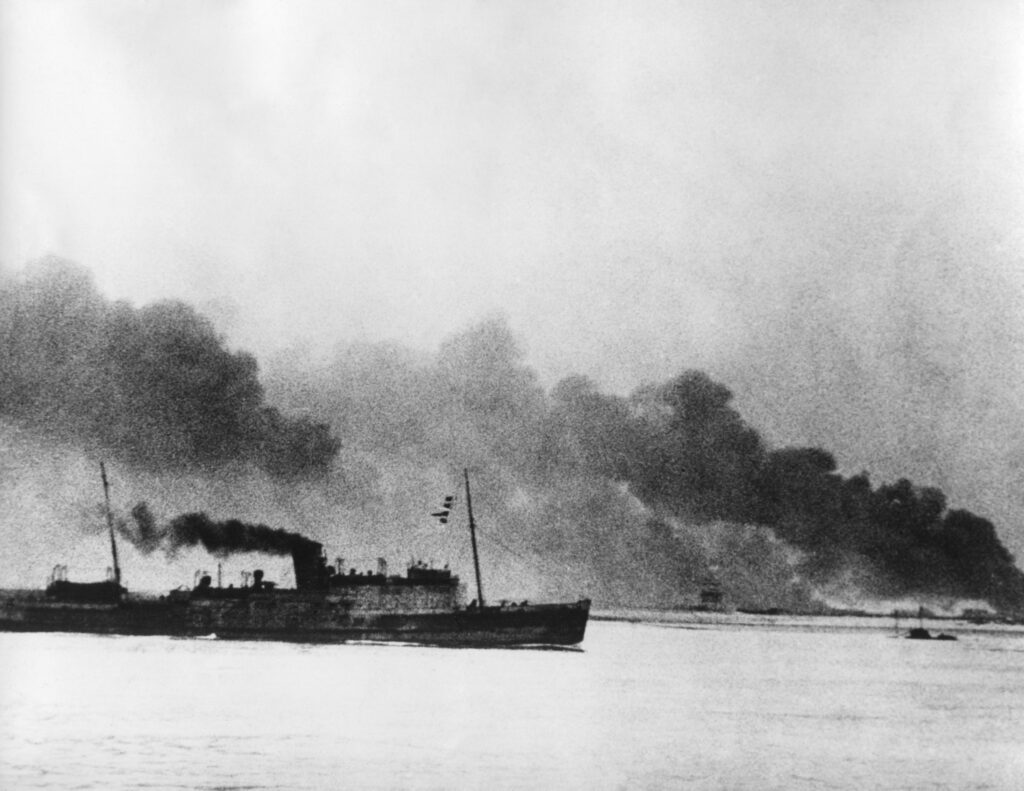
On May 22, 1940, the Pact of Steel was signed between Benito Mussolini and Adolf Hitler, formalizing the October 25, 1936 Rome-Berlin Axis agreement, linking both countries from a political and military standpoint. Later, Japan joined the two countries in the Tripartite Pact (see below).
Progression in France
In France, it took about a month from the Sudan attack until June 14, 1940 when the Germans entered Paris. In other words, about nine months after the commencement of WWII, Germans occupied Paris.
Two days later, on June 16, 1940, Marshal Philippe Petain (France’s hero of WWI) requested an armistice. Thus, France fell, and it was divided into two zones, one under German military occupation and the second under Petain’s government at Vichy, France. Thus, France was no longer with the Allies.
Soviet Invasion of Baltic States
On June 15, 1940, the Soviet Union invaded Lithuania. The next day, the Soviet Union invaded Latvia and Estonia. This was the same week that Nazi Germany was conquering France.
German Attack on Britain
Having conquered France, Hitler now moved on to the next big target, Britain, in what was called Operation Sea Lion. Hitler thought Britain would give in easily. It did not!

Churchill was brave, as reflected in his famous speech in the House of Commons on June 4, 1940:
“We shall fight on the beaches, we shall fight on the landing grounds, we shall fight in the fields and in the streets, we shall fight in the hills; We shall never surrender, and even if, which I do not for a moment believe, this island or a large part of it were subjugated and starving, then our Empire beyond the seas, armed and guarded by the British fleet, would carry on the struggle, until, in God’s good time, the New World, with all its power and might, steps forth to the rescue and the liberation of the old.”
July to September 1940, during the Battle of Britain, the British Royal Air Force (RAF) defeated the German Luftwaffe. This was the first major defeat for Hitler.
During this time, on August 4, 1940, the East African Campaign or Desert War also began. (See below.)
After the defeat of the Luftwaffe, toward the end of October, Hitler decided to postpone his plans to invade Britain.
However, The Blitz now began in which Germany bombed Britain for about eight months, including London and other British cities. It lasted from September 1940 to May 1941.
Formation of Axis Powers of WWII
While the bombing of London was happening, The Tripartite Pact was signed on September 27, 1940, in Berlin by Germany, Italy, and Japan. This pact created the Axis Powers of WWII. This pact was later joined by Hungary (November 20, 1940), Romania (November 23, 1940), and Bulgaria (March 1, 1941).
Lend-Lease Act
The US supported Britain. Winston Churchill received valuable aid from the US during the presidency of Franklin Delano Roosevelt (FDR) under the Lend-Lease Act, which was passed in March 1941 by the US Congress. Under this act, the US government was able to lend or lease war supplies to any nation it considered vital to the defense of the US.
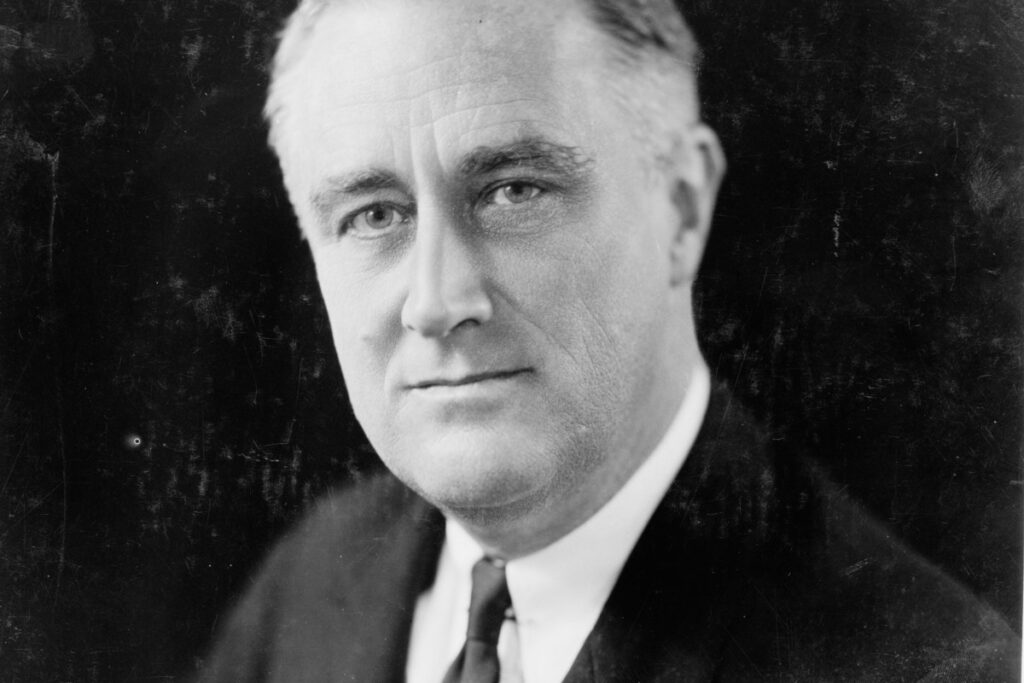
Invasion of the Soviet Union
Not having success with Britain, Hitler turned his focus to the Soviet Union, Germany’s ally in the war against Poland.
To the great surprise, shock, and disbelief of Stalin, Hitler launched his “Operation Barbarossa” on June 22, 1941, a full invasion of the Soviet Union. About 3.7 million men were included in the military forces that came from Germany, Italy, Romania, and Hungary.
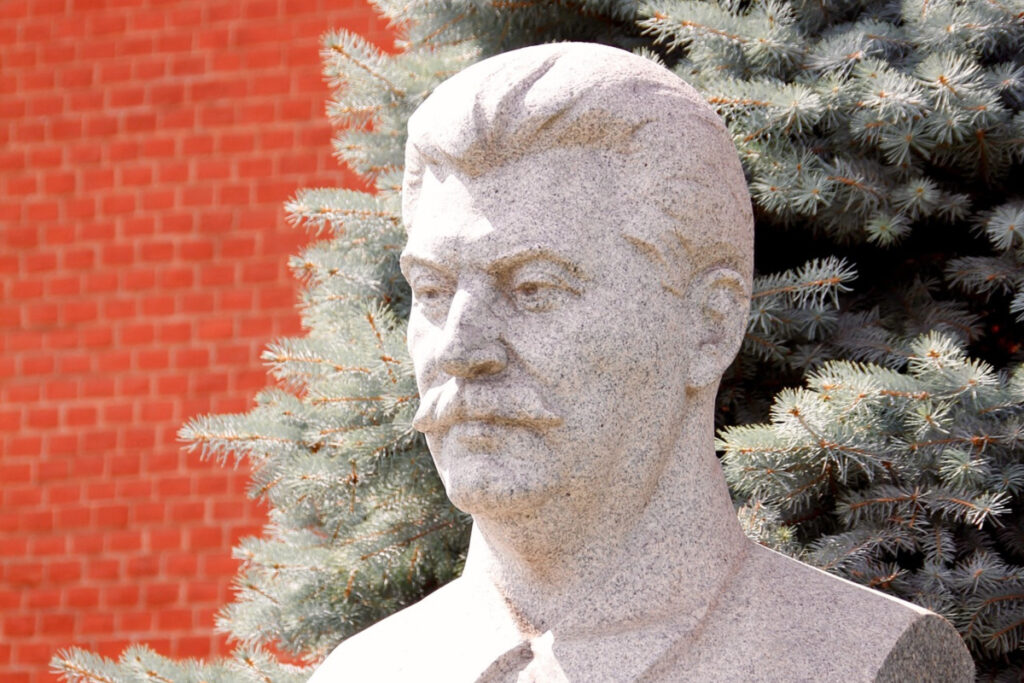
By mid-July, the German troops were within 200 miles of Moscow! On July 16, 1941, Smolensk fell to the German troops.
By late September 1941, German troops reached Leningrad.
The US enters WWII
On Sunday, December 7, 1941, Japanese aircraft attacked Pearl Harbor in Hawaii and more than 2,300 US troops died. The next day, the US Congress declared war on Japan and the US entered WWII.
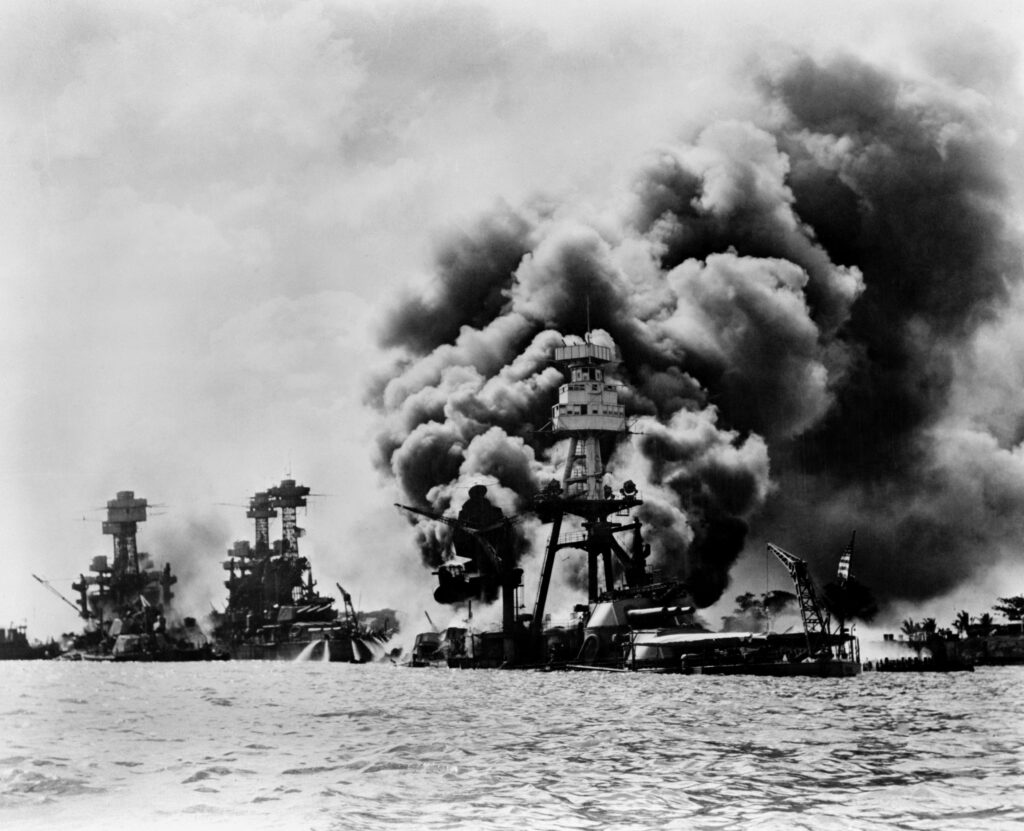
Turning the Tables in the Soviet Union
The Battle at Stalingrad (August 1942—February 1943) finally resulted in a German defeat, a turning point in the war.
Note that simultaneously, the war continued in Africa, and Operation Torch occurred from November 8-16, 1942. (See below.)
Coming back to the Soviet Union, the Germans surrendered to the Soviets on January 31, 1943.
The African War or Desert War: “Ping-Pong War,” “See-Saw War,” or “Yo-Yo War”
I like to call this segment of WWII the “Ping-Pong War, See-Saw War, or Yo-Yo War.” The dictionary definition (Dictionary.com) for all three terms is to go back and forth. I choose these names because the success platform moves from one side to the other back and forth as shown below.
Perspective: Following the fall of France and the British withdrawal at Dunkirk, North Africa was one of the regions that came to the forefront. Two reasons for this were that the Suez Canal was crucial to controlling the Middle East and the importance of Middle Eastern oil resources.
After the North African Campaign came the Italian Campaign.
The North African campaign extended from 1940 to 1943. North Africa is usually thought to include Algeria, Egypt, Libya, Mauritania, Morocco, Sudan, Tunisia, and the Western Sahara. US troops didn’t get involved in the campaign until 1942.
The Stage: In Libya, the Italian army consisted of more than one million men under dictator Benito Mussolini. In contrast, adjacent Egypt had only 36,000 British troops. Strategically, Egypt was important due to its location, with regard to the Eastern Mediterranean, Middle East, Suez Canal, and Abyssinia (now known as Ethiopia).
Some of the major battles in this region included the Battle of Gazala, the First Battle of El Alamein, and the Second Battle of El Alamein.
Ping-Pong War:
The East-African Campaign: Italians Successful—British Commonwealth forces included troops from India, South Africa, Nigeria, and Ghana. The other side was the Italian army. This campaign began on August 4, 1940, with the Italian forces invading British Somaliland and capturing its capital on August 19.
British Successful: Next, the Commonwealth forces attacked the Italian troops, both from Sudan in the north and Kenya in the south. This resulted in British victory and Italian defeat after about three months.
Western Desert Campaign: Italians Successful—Commenced September 13, 1940. An Italian army from Libya invaded British-held Egypt and the Italians were successful.
British Successful: British (Allied forces) offensive—the British counterattacked the Italians in Operation Compass. The British were successful and advanced to El Aghelia.
German Interjection: Axis Powers/Germans Successful—Hitler decided to help the Italian Axis force. General Erwin Rommel launched the German offensive and drove the two sides to about their original locations.
Allies Successful: The Allied forces reorganized with armies from Australia, India, South Africa, and New Zealand. They were successful in recapturing all the regions that Rommel had acquired.
Germans Successful: Rommel received supplies and then reattacked. He defeated the Allies and pushed them back to the Egyptian border.
Allies Successful: Operation Torch (November 8-16, 1942)—Allied invasion of French North Africa. US General Dwight D. Eisenhower was the supreme commander of Allied forces in the European region. Major victory for the Allies.
On November 8, 1942, the Allied forces landed in Algeria and Morocco. Allied forces gained Tunisia.
Germans Successful: At the Battle of Kasserine Pass, Rommel was able to stall the Allied forces and obtain a German victory.
Allies Successful: American counterattack—The US restructured its forces and was successful in pushing Rommel through the Kasserine Pass to the Mareth Line.
You can see from the above why I like to call it the “Ping-Pong War.”
Final Surrender: On May 12, 1943, the Axis forces surrendered to the Allies.
This concluded the North African Campaign and gave way to the Italian Campaign.
Focus on Italy:
Allies successful: Operation Husky or the Invasion of Sicily occurred next. Its goal was to get rid of Axis forces in Sicily and possibly topple Mussolini’s government. Key leaders included Eisenhower, Alexander, Paton, and Montgomery. The fall of Palermo, the Sicilian capital, was followed by the collapse of Benito Mussolini’s government in Rome.
In July 1943, Mussolini’s government fell. It was the first Axis Power to be defeated.
On September 8, 1943, a New Italian Government led by Pietro Badoglio surrendered to the Allied forces. However, although the Italians surrendered, the Germans continued to defend the country. When Allied forces conquered Salerno, the Germans withdrew to the northern defensive line.
Axis forces then captured both Naples and Foggia.
Final Campaigns in Italy
On April 29, 1945, the Germans surrendered to the Allies and the war ended in Italy.
Let us now go back to Europe:
D-Day in France
June 6, 1944 was D-Day, with the massive invasion of Europe by the Allied forces—156,000 British, Canadian, and American soldiers landed on the beaches of Normandy, France.
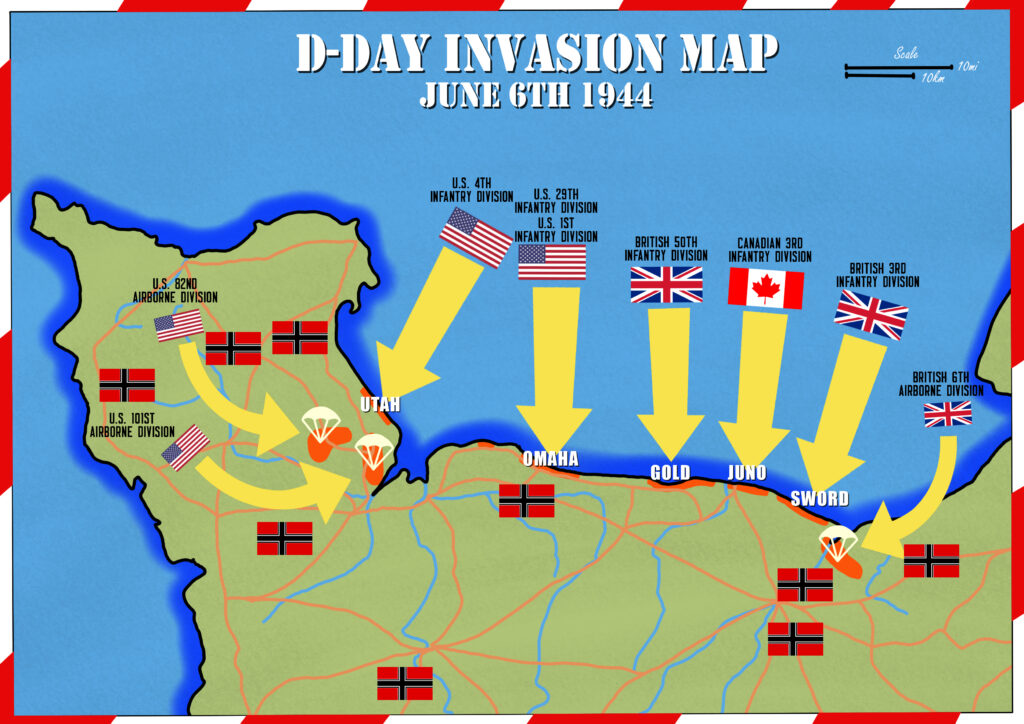
In response, Hitler poured all the remaining strength of his army into western Europe. Unable to fight effectively in the western and eastern fronts simultaneously, Germany was defeated in the east. Soviet troops soon invaded Poland, Czechoslovakia, Hungary, and Romania.
Battle of the Bulge
Hitler’s final effort was the Battle of the Bulge from December 1944 to January 1945. Here Hitler tried to drive the American and British forces back from Germany.
On April 30, 1945, Hitler committed suicide. Within days, Berlin fell to the Soviet forces. The Germans surrendered unconditionally on May 7, 1945 in the west and on May 9 in the east. Victory in Europe (V-E Day) was proclaimed on May 8, 1945 with celebrations in many parts of the world.
Germany was the second Axis Power to fall to the Allies.
The third and only remaining Axis Power, Japan, continued its war in the east. (To be covered in Part 3.)
One of the Major Atrocities of WWII: The Holocaust
The Holocaust was the systematic state-sponsored killing of 6 million Jewish men, women, and children by Nazi Germany during WWII. The Nazis called this the final solution. The largest number of the dead was three million from Poland, with the Soviet Union being second with one million, and third was Hungary with 550,000.
It is estimated that about 58 percent of all Jews in Europe died during Holocaust. The total number of Jews and non-Jewish people killed during the Holocaust was between 15 and 20 million.
There are no true winners in any war of this magnitude. There is only sorrow, loss, and destruction. Humans continually fail to learn that nothing good usually comes out of war. We need to embrace and cherish peace and live harmoniously with other human beings all over the world.
Let love unite us, and let not hate divide and destroy us….
References and Further Reading
- https://en.wikipedia.org/wiki/Nazism
- https://www.history.com/topics/world-war-ii/nazi-party
- https://www.dictionary.com/browse/annexed
- https://en.wikipedia.org/wiki/Great_Britain#:~:text=Great%20Britain%20is%20an%20island%20in%20the%20North,island%2C%20and%20the%20ninth-largest%20island%20in%20the%20world.
- https://www.bbc.co.uk/bitesize/guides/z8dnxsg/revision/1
- https://www.thoughtco.com/number-of-jews-killed-during-holocaust-by-country-4081781
- https://u-s-history.com/pages/h1727.html
- https://www.dictionary.com/browse/ping-pong)
- https://www.dictionary.com/browse/see-saw?s=t)
- https://www.dictionary.com/browse/yo-yo?s=t)


Latest posts by DrTJ (see all)
- Emotional Intelligence: The Secret to Building Strong Relationships and Achieving Success - April 17, 2023
- Procrastination – Definition, Perspective, and Overcoming It - February 15, 2021
- Breaking Point, Boiling Point, and Beyond - February 5, 2021
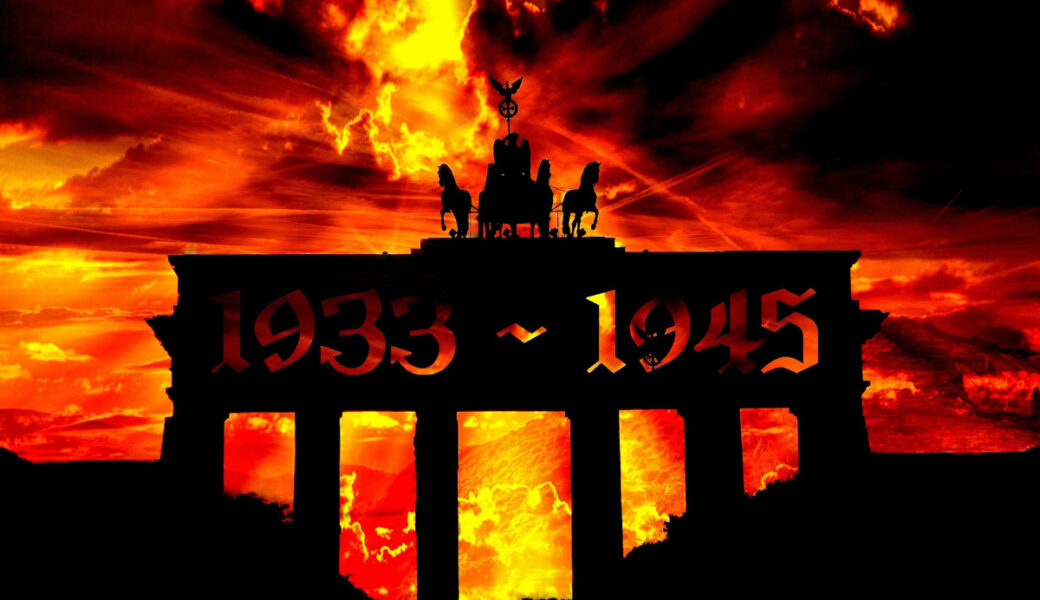

Thank you, Dr. TJ, for the informative post. World War II is definitely a lot to comprehend, so I appreciate how you made it so accessible. I especially like that you mentioned Romania and Bulgaria. They are usually forgotten as Axis Powers, although they were coerced into siding with Hitler. I visited them last year and stayed at a hotel in Bucharest that had been bombed by the Americans. Fortunately, Romania later changed sides and the people I talked to acknowledged they were on the wrong side in the war. Anyway, looking forward to future installments.
Tyler – Thank you for your supportive comments. That is true, regarding the complexity of world war II. That was the reason I tried to simplify this global war for all the readers wherever they may be located in the world.
An amazing post! I have a BA in history and an MSS from the U.S. Army War College and have studied World War II. Dr. John’s posting is excellent, accurate and presents information the human race must learn and never forget. WWII was a battle between good and evil which occurred in the not too distant past. If humans do not learn the lessons outlined in Dr. John’s post, we are doomed to repeat them. Thank you Dr. John for your post and for outlining the tremendous evil and good humans are capable of exacting on each other. Most of all, thank you for showing that good will always conquer evil.
Sean- Thank you for such a strong feedback especially from someone who is from the U.S. Army War College. Yes, I agree that the war brings out the good and the evil from humans, who, enter this world as innocent angels. We need to embrace the good over evil. The path may be challenging and it may take longer to reach the final destination in our lives, but it is all about choosing the right path, and the right path is always the path of good and staying away from the path of evil. Let more unite under the banner of GOOD and together we can make a difference towards a better, healthier, and prosperous new world!
I always emailed this blog post page to all my associates, as if like to read it after that my contacts will too. Christal Etienne Zeralda
What a information of un-ambiguity and preserveness of precious knowledge about unpredicted feelings. Daphna Carolus Ummersen
DrTJ- Thank you for a clear and concise summary of the WWII European and African theatres. It’s better than any description I’ve read, which has been many years ago. Most importantly you remind us what to be on the lookout for when new “Not So Good” leaders come along. Appeasement cannot be tolerated when dealing with megalomaniacs.
Looking forward to your upcoming essays.
Mitch- Appreciate your strong positive feedback regarding the blog on WWII. This war war brought about human suffering and loss of life on a scale and magnitude that humans have never before experienced on earth. It is important to recognize the balance of good over evil, peace over tyranny, democracy over no democracy and early steps to prevent such negative atrocities as in WWII are important for a better tomorrow not just for us , but for our children and grandchildren in the times ahead. Let us all pledge for more good, more love, and more caring attitudes towards one another and transform our world!
Dr. TJ,
Thank you for the succinct breakdown of the forces and wills behind WWII. Until your essay, I knew only a simple understanding. I look forward to parts II and III.